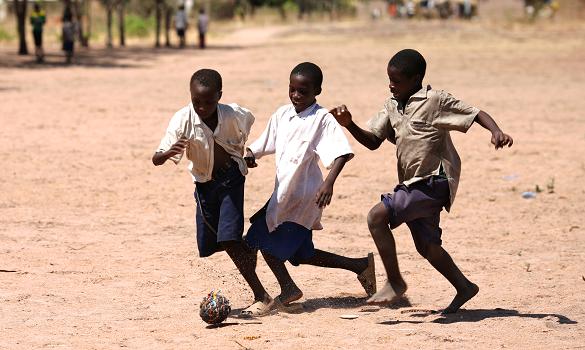This is a very interesting story from Matthwe Syed in The Times of London. While in Tanzania last week doing work for the paper’s yearly charity appeal, he stumbled upon what he calls the “one powerful and irrepressible aspect of familiarity. Football.”
He writes in the article:
Many have written eloquently about the transcendentalism of what is sometimes called “the beautiful game”. About how one can travel to any corner of this diverse planet and find a shared devotion to the sport of kicking a bladder between sticks. Football has become the universal language, the lingua franca, the one common theme in a world divided in so many ways.
Indeed, so familiar are we with the universality of this British invention that we are no longer astounded by its scope. But we should be. When future historians look back at the age of globalisation, it is not the Americanisation of the planet’s culture that will amaze them most, nor the pervading presence of brands such as Coca-Cola and Nike. No, it is the global conquest of football.
While many have argued that football has become a global commodity that bounds together fans from every corner of the world with their love and need for the game. Syed makes a compelling case about the artistic nature of football and its transcendental appeal. (You can decide for yourself if Jackson Pollack belongs on the same field with Zinedine Zindane, literally.)
The full article, “Football unites, from Tanzania to Tottenham,” can be found at http://www.timesonline.co.uk/tol/sport/columnists/matthew_syed/article6911390.ece, with an excerpt below.
(Excerpt)
Football unites, from Tanzania to Tottenham
Last week I was in Tanzania for this year’s Times charity appeal (of which more later in the month). I flew to Dar es Salaam, on the east coast and then drove ten hours inland, culminating at Idodi, a charming but desperately poor village on the border of the fabled Ruaha National Park, a vast area of savage and compelling beauty.
In Idodi there is no running water, no industry, no electricity. Light is obtained in the evenings using kerosene lamps. Food is provided by subsistence farming. Housing is of the stone and mud hut variety, with more than a dozen often living in only a couple of rooms. Clothing is a mix of old and new, with the Masai wearing elaborate and colourful wraps and carrying long staffs.
In short, Idodi is a place not merely separated from the West in terms of geography, but in almost every other conceivable way. Arriving in the village was not merely to land on a different continent but to inhabit a different epoch. This is a different culture, a different climate, a different modus operandi, a different set of values and traditions. A place with different perspectives and wholly different challenges.
But there is — and this is the point of this preamble — one powerful and irrepressible aspect of familiarity. Football.

Many have written eloquently about the transcendentalism of what is sometimes called “the beautiful game”. About how one can travel to any corner of this diverse planet and find a shared devotion to the sport of kicking a bladder between sticks. Football has become the universal language, the lingua franca, the one common theme in a world divided in so many ways.
Indeed, so familiar are we with the universality of this British invention that we are no longer astounded by its scope. But we should be. When future historians look back at the age of globalisation, it is not the Americanisation of the planet’s culture that will amaze them most, nor the pervading presence of brands such as Coca-Cola and Nike. No, it is the global conquest of football.
As I walked two miles north from the village to the local secondary school, avoiding snakes and scorpions in the long grass, I reached a large clearing comprised of gravel and sand. Two schoolboy teams stood in the middle of the space kitted out in blue and red. The ball was not quite round, the goals were branches shackled together with rope and there were no lines to demarcate the areas of the pitch.
(The article continues at http://www.timesonline.co.uk/tol/sport/columnists/matthew_syed/article6911390.ece)



Recent Comments